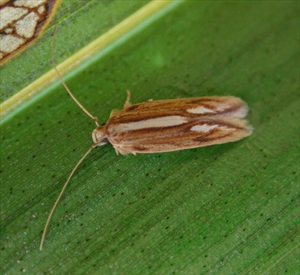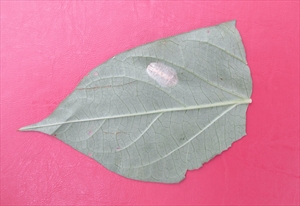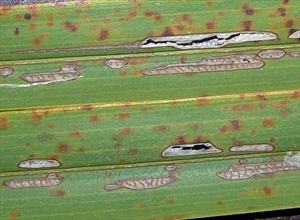Coconut flat moth
Pacific Pests, Pathogens, Weeds & Pesticides - Online edition
Pacific Pests, Pathogens, Weeds & Pesticides
Coconut flat moth (065)
Agonoxena sp. The main pest species of Pacific Island countries is Agonoxena argaula. Agonoxena pyrogramma also occurs.
Oceania. Agonoxena argaula, the coconut flat moth, is recorded from American Samoa. Tokelau, Tonga, Tuvalu, North America (Hawaii), Vanuatu, and Wallis & Futuna. Agonoxena pyrogramma is recorded from Guam, Federated States of Micronesia, Northern Mariana Islands, Papua New Guinea, and Solomon Islands.
Coconuts and other palms.
The larvae of the flat moth do the damage by eating mainly the lower surface of the leaflets. They make light grey lines 1-2 mm wide and 2-3 cm long near the mid-rib.
The adult is 5-9 mm long; the female is yellowish brown, and the males have white stripes on the forewings (Photos 1&2). Eggs are laid on the underside of the leaflets, near the tips and along midribs, singly or in rows (Photo 3). Larvae or caterpillars are green and up to 2 cm when mature (Photo 4); they spin a fine web and shelter under this, feeding on the top layers of the leaflets, parallel to the veins (Photos 5&6). They become active when disturbed, moving backwards or forwards or dropping to the ground. When mature, they spin a white web and pupate, either on the leaflets or on the undergrowth.
Occasionally, the flat moth is a serious pest of coconuts and other palms. The larvae feed on the underside of the leaflets of the fronds. Damage starts on the middle aged leaves, and continues on older ones, affecting up to 40% of the leaf surface during outbreaks. In Fiji, caged palms with 25% leaf damage recorded 20% reduction of nuts, although some researchers think this level of damage rarely occurs in the field. In general, it seems likely that heavy damage to coconut leaves reduces yields, but it is not clear what the effects are of low levels of damage over a long period. However, it is possible that the growth of seedlings may be slowed by the attack.
Damage from Agonoxena pyrogramma, which is heavily attacked by parasites, is much less than Agonoxena arguala. Both species are more abundant during periods of dry weather, possibly because of the impact of the weather on the natural enemies of the moths.
Look for long, thin, grey patches of damage on the leaflets where the larvae have fed; these are characteristic of the pest. Look for the larvae under a thin web covering the leaflets.
NATURAL ENEMIES
Many insects have been introduced into countries of the region to control Agonoxena arguala; these are mostly wasps, braconids and chalcids that attack larvae or pupae. They have come from Fiji, India, Indonesia, Papua New Guinea and Samoa. Introductions need to be done carefully because of the presence of hyperparasites, i.e., insects that attack the natural enemies of the flat moth.
Ants are reported to destroy Agonoxena arguala pupae and may eat eggs; spiders sometimes attack adults. In Fiji, a fungus destroyed a high proportion of the pupae, and also killed the larvae and adults. Although the natural enemies are not known in Solomon Islands, they are likely to be similar to those of Agonoxena arguala.
A tachinid fly has been reared from Agonoxena pyrogramma in Solomon Islands, and Waterhouse and Norris in their book Biological Control Pacific Prospects quotes others that "parasite introductions against Agonoxena pyrogramma have been successful", without giving details.
CULTURAL CONTROL
No recommendations.
RESISTANT VARIETIES
None reported.
CHEMICAL CONTROL
- Insecticides are not recommended for the control of this insect on mature coconuts, although they may be useful on seedlings. In the normal situation, natural enemies of the flat moth keep the pest under control. If serious outbreaks do occur, the use of pesticides might be tempting, but are more likely to delay a return to biological control. Additionally, insecticides are difficult to apply to mature palms as well as being ineffective and costly.
- If insecticides are required on, say, seedlings in the nursery, synthetic pyrethroids are likely to be effective, but will also kill natural enemies.
____________________
When using a pesticide, always wear protective clothing and follow the instructions on the product label, such as dosage, timing of application, and pre-harvest interval. Recommendations will vary with the crop and system of cultivation. Expert advice on the most appropriate pesticides to use should always be sought from local agricultural authorities.
AUTHORS Helen Tsatsia & Grahame Jackson
Information from Waterhouse DF, Norris KR (1987) Agonoxena argaula Meyrick. Biological Control Pacific Prospects. Inkata Press. Photos 1,2&4 Gerald McCormack, Cook Islands Biodiversity & Natural Heritage. (http://cookislands.bishopmuseum.org).
Produced with support from the Australian Centre for International Agricultural Research under project PC/2010/090: Strengthening integrated crop management research in the Pacific Islands in support of sustainable intensification of high-value crop production, implemented by the University of Queensland and the Secretariat of the Pacific Community.









